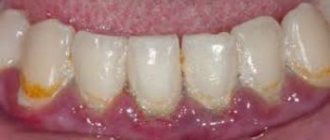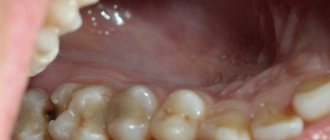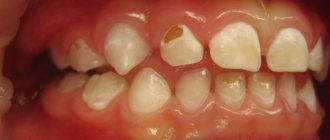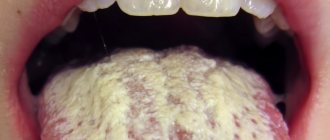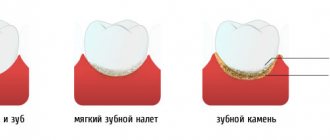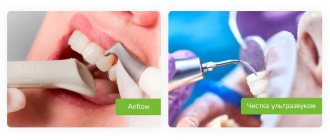Many parents ignore plaque on their child’s teeth and believe that the bite is not permanent and that the teeth will soon change. This is a misconception. Yellow, black, brown deposits on the enamel not only spoil a child’s smile, but also cause caries and gingivitis (inflammation of the gums). Under the milk teeth lie the rudiments of permanent ones; it is necessary to prevent diseases of the temporary predecessors so that the permanent teeth erupt without defects and are healthy.
What is Priestley plaque on teeth?
This is a dental problem that occurs in children. In this condition, deposits are found on the enamel of the teeth. Dark plaque on a child’s teeth can be black or brown, sometimes with a light or pearlescent tint. As a rule, it is located as a thin border along the lower edge of the teeth closer to the gums. But plaque can also cover a large area of the tooth or look like a small spot on the enamel. Most often, dark deposits appear on the inside of the teeth, less often in the interdental space or on the outer surface of the teeth.
Photo courtesy of InWhite Medical Clinic
What are the types of tartar?
Dentists distinguish two types of tartar – subgingival and supragingival. They are classified according to their location on the tooth surface. Supragingival can be easily seen with the naked eye, is whitish-yellow or gray in color and is easily removed by scraping. Minerals that come from saliva take part in its formation. The predominant localization of such a stone is the area of the buccal surfaces of the upper molars, where the ducts of the salivary glands and the frontal teeth of the lower jaw emerge.
The second type of tartar can only be detected by a dentist during probing. Its formation involves minerals that come mainly from gingival fluid. Most often, it has a dark brown color and a greenish tint, and is localized in most cases on the root cement, on the neck of the tooth (near the gingival groove) and on the root cement. The stone covers the neck of the tooth and is tightly attached to its surface; it can often form protrusions.
How to detect dark plaque in time
- regularly examine the child’s oral cavity independently;
- do not postpone scheduled visits to the dentist.
It must be taken into account that Priestley plaque on the teeth often accumulates slowly, which is why the child gets used to the stains on the enamel and does not tell his parents about them. Darkening of teeth can occur quickly, literally overnight. Reactive appearance most often occurs during illness, accompanied by intoxication, dehydration and increased body temperature. This is due to the fact that the child’s body reacts sharply to various changes in diet, the functioning of internal organs and in external conditions.
Deposits most often occur at the age of 2-3 years. However, they can also appear on the very first milk teeth of a one-year-old child. Or it could affect the baby teeth of a younger teenager who haven’t had time to change. The darkening may also spread to permanent teeth.
Prevention of dental plaque in children
Prevention of dental diseases should begin with the appearance of the first milk teeth. The following recommendations must be followed:
- brush the newborn’s teeth from the moment of teething using a special silicone fingertip;
- by the age of 2-3 years, accustom the child to cleaning the oral cavity independently in the morning and evening;
- change your baby’s toothbrush every month, buy hygiene products intended for children of the appropriate age;
- Bring your child for a preventive examination to the dentist every 4 months, even if there is no plaque or other symptoms;
- limit the consumption of sweets, include healthy foods without fast carbohydrates and with minerals in the children's menu.
The baby may also be bothered by other symptoms that he cannot tell an adult about. Therefore, bring him for examination, regardless of what color plaque has formed on his teeth.
Why does a child have black plaque on his teeth?
The main problem with the appearance of Priestley plaque on teeth is not that it causes bad breath, looks unsightly, or cannot be removed independently without the help of a hygienist. Priestley's plaque is a signal that something has changed in the child's body, due to which non-dangerous bacteria began to actively multiply, creating deposits. And for high-quality treatment and prevention of the development of diseases, it is necessary to find out why black plaque forms on the teeth, the reasons for the appearance of beneficial living conditions for bacteria.
Possible causes of plaque:
➢
diabetes;
➢
genetic feature or hereditary predisposition;
➢
thyroid diseases;
➢
incorrectly selected hygiene products;
➢
parasite infection.
Dysbacteriosis.
Disruption of the gastrointestinal tract can occur due to malnutrition, food poisoning, immaturity of the digestive system, taking antibiotics or chronic diseases of the stomach, liver, and intestines.
Caries.
Due to the fact that parents usually do not brush their baby’s first teeth, yellow plaque begins to accumulate on the enamel, which over time can cause caries. Irregular or insufficiently high-quality tooth brushing by the child himself also leads to the formation of caries. Carious lesions create a favorable environment for the growth of bacteria, which causes Priestley plaque to appear on baby teeth.
Dehydration.
Due to dehydration due to various reasons, the body cannot produce enough saliva to wash the teeth and remove food particles. Because of this, bacteria begin to multiply faster, and a dark plaque forms on the child’s teeth. Therefore, it is important to ensure that your baby gets enough fluids, especially in hot weather or during illness.
Hypoplasia of tooth enamel.
Some children have underdeveloped top layer of enamel. It is weakened and unable to perform a protective function.
Disorders of dental development in the prenatal period.
Dental buds may be damaged during development due to viral infections suffered by the mother, calcium deficiency, iron deficiency, or taking certain medications.
Improper functioning of the immune system.
Malfunctions in the immune system can affect the body's ability to suppress bacterial activity.
Malocclusion.
If a child has a malocclusion, the load on the jaw when chewing is distributed unevenly, which is why some of the teeth receive increased load, but are cleansed with solid food: carrots, apples. And unused teeth become covered with plaque.
Reasons why tartar forms
Local factors play a major role in the formation of tartar. For starters, this is poor oral hygiene in childhood. In addition, the cause of tartar is an insufficient intake of solid foods. Also, tartar in large quantities occurs as a result of the lack of pyrophosphate in saliva - a substance that retards the development of dental plaque and the lack of protein in it, which tends to slow down the growth of crystals. Tartar on children's teeth is not always obvious. Calcium phosphate crystals can bind tightly to the surface of the enamel, making it often difficult for the dentist to determine where the stone begins and the enamel ends.
Diagnosis of Priestley plaque on teeth
If darkening is detected on the enamel of a child’s teeth, you must contact a dental clinic.
The specialist will:
✔
inspection;
✔
laser diagnostics to determine the depth and size of the lesion;
✔
anamnesis collection.
After a conversation with the parent and child and collecting an anamnesis, the pediatric dentist will immediately prescribe treatment or conduct an additional examination. You should not neglect it - it is important for a specialist to find out why the child has black plaque on his teeth. Only after this will he be able to provide quality treatment.
Provoking factors
The main reason why tartar forms in young children is poor oral hygiene. Even parents are not always able to thoroughly clean children’s teeth, so, as a rule, large plaque accumulates in hard-to-reach places.
The provoking factor may be:
- lack of solid food in the child’s daily diet;
- bite pathologies;
- long-term use of antibiotics;
- gastrointestinal diseases.
It is not always possible to eliminate the provoking causes of tartar in a child, so dentists recommend that parents constantly monitor the quality of their teeth cleaning.
Additional protective measures for Priestley's raid
It is possible that Priestley's plaque on the teeth appeared due to an infection and, as a result, a temporary deterioration in the functioning of the immune system. But it is necessary to make sure that there are no serious and dangerous deviations in the child’s health. Therefore, if dental plaque is detected, the dentist will recommend taking additional measures:
- get tested for the presence of parasites in the body;
- consult a gastroenterologist;
- take tests to check the level of iron and calcium in the body;
- check your blood sugar levels.
These measures will help identify the problems that are causing plaque to form on your teeth.
How to remove black plaque on teeth
It is impossible to remove dental plaque at home. Moreover, the use of abrasive agents and intense exposure to teeth with a brush can cause an increase in dental problems: thinning or damage to the enamel, trauma to the gums or mucous membrane.
Priestley's plaque on children's teeth can only be removed in a well-equipped dental clinic. The specialist will:
- professional teeth cleaning;
- If necessary, treat the teeth with a remineralizing composition.
If plaque formation is caused by dental problems, additional treatment may be prescribed, including bite correction.
The doctor will also select a home hygiene kit that is ideal for the child: a toothbrush of the correct shape and hardness, toothpaste with the optimal composition, and mouth rinse. Additionally, the hygienist will teach the child how to brush their teeth correctly and will talk about the need for quality oral care.
Taking into account the causes of the disease, the dentist may prescribe additional treatment measures, for example, recommend dietary supplements, dietary nutrition, avoidance of drinks and foods with dyes that affect the color of the enamel.
How to prevent it?
The main task of parents is not to cure the disease, but to prevent it! Therefore, certain measures should be taken to prevent mineral deposits on teeth:
- As soon as the first teeth appear, you need to teach the child to eat solid food, do not follow the lead of the little lazy person - do not chop carrots and apples;
- You should brush your teeth with a children’s brush, which is better to buy on the recommendation of a dentist;
- You need to change the brush every 2-3 months;
- Teach your child to brush their teeth correctly. The doctor will give you all the necessary recommendations at your appointment.
- purchase pastes with pyrophosphate (but strictly in accordance with the age of the baby).
But the most important rule is to bring your child once every six months for a dental examination. This will not only help get rid of tartar, but also prevent serious diseases in the future that are caused by mineral deposits: periodontitis, gingivitis, stomatitis.

